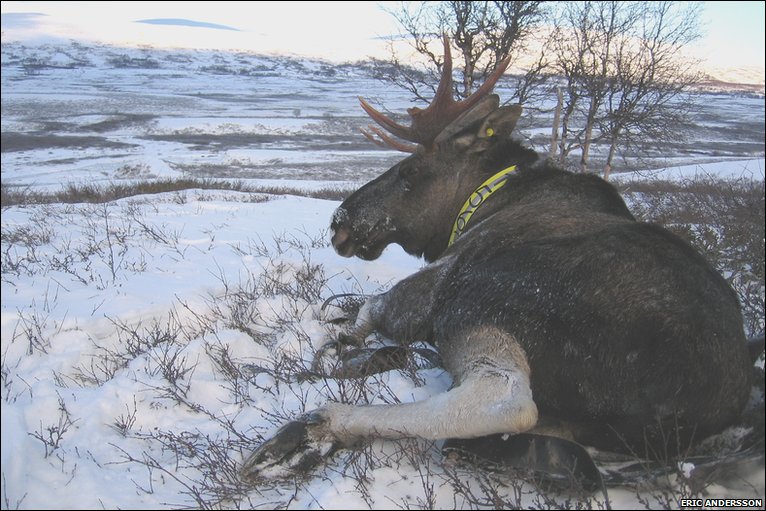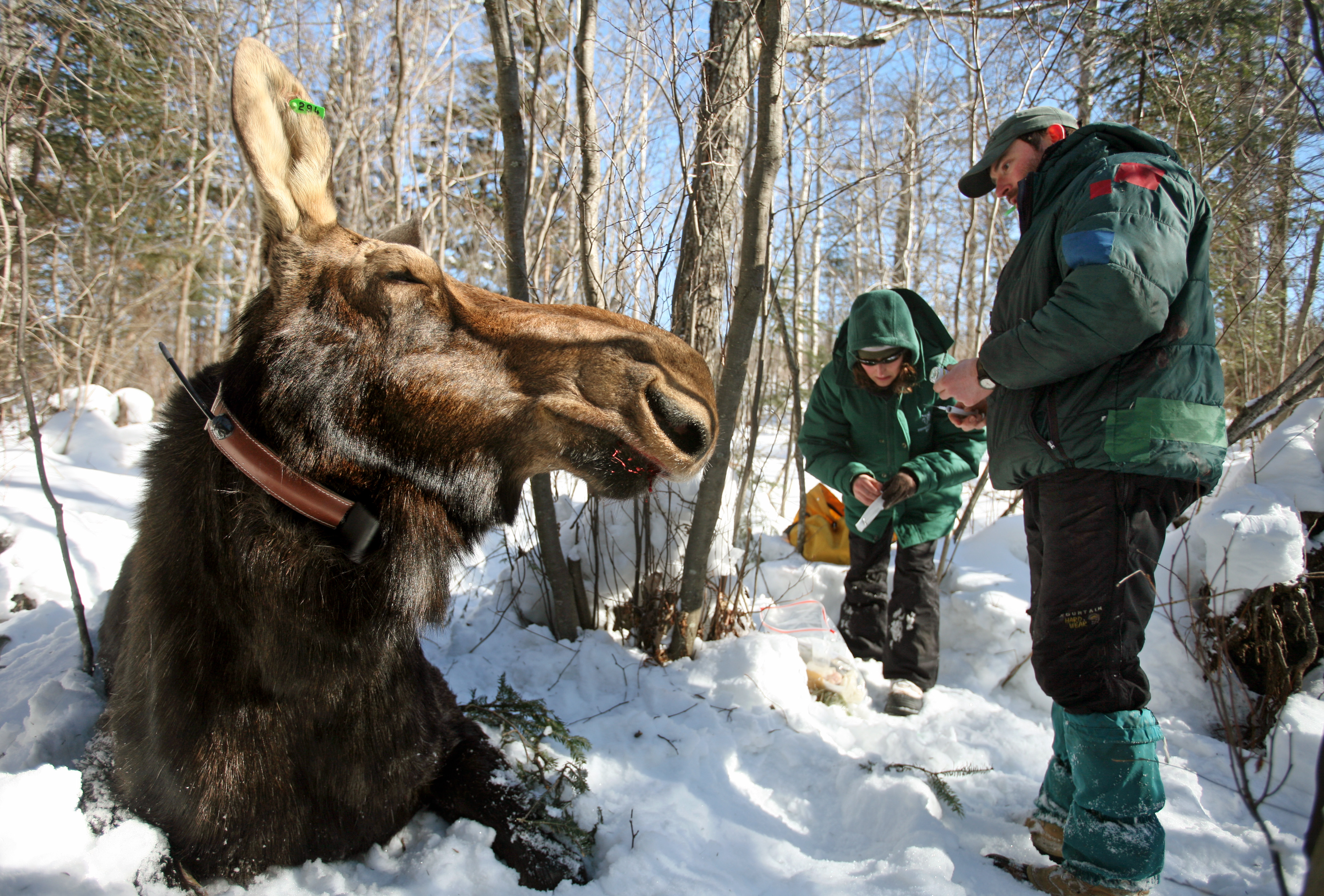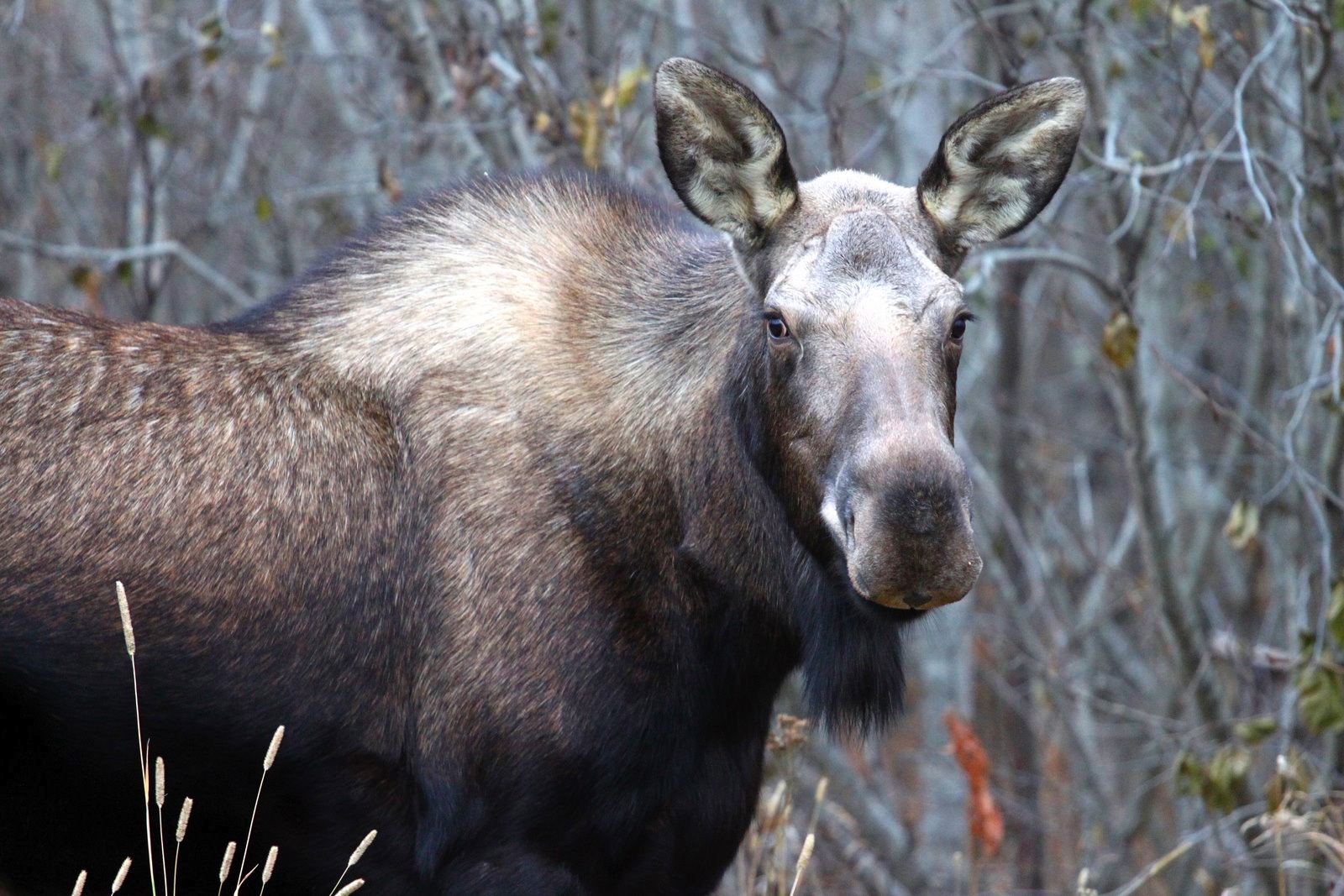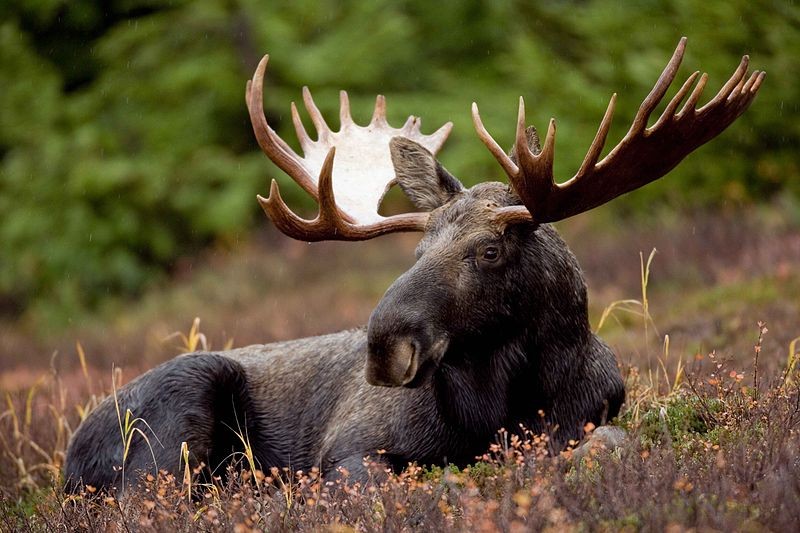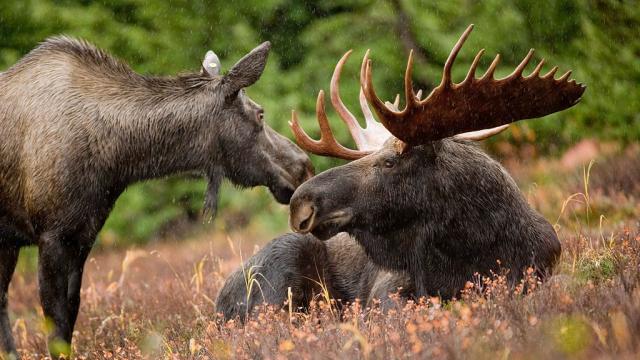
Prehistoric in appearance, gangly to the point of ridiculousness when you see one galloping, awesomely beautiful rising out of a bog with water dripping from a sprawl of antlers, a moose can run 35 miles an hour, stay submerged in water for 30 seconds and eats about 10,000 calories of bark and fresh shoots and aquatic mush on a typical day.
A moose is wonderfully ancient. In contrast, we're modern, carbon-addicted two-legged critters, restless and dumb and hastening their demise. We run over them, shoot them easily because they rarely flee. And now the climate shadow of our consumptive lifestyles helps infect them with ticks that drive them mad with scratching.
My last close encounter with Alces alces, a survivor since the Pliocene epoch and smaller now than then, occurred a couple years ago in the fall. Out cruising on a back road in northern Vermont, out the corner of my eye I noticed some big animal. Probably a cow, I thought. But then it was galloping kind of funny, the way moose do, and angling toward me. It had a huge rack and was definitely on a tack that said, Collision!
I slammed on the brakes. The moose slammed into my bumper, splattering mud and moose hair on the hood and windshield. Apparently unharmed, it wobbled around on its five-foot tall legs as I turned my engine over and over. It had stalled.
It started. I drove off.
Dazed and horny, the bull moose stood there mightily. It was the rut and he had, I believe, mistaken my darkish car for one of his own. Or he was just nuts.
In the boreal forests of the Northeast United States a moose can live to be fifteen years old, even twenty. But it's not likely. The mortality rate, especially for yearlings who, like adolescent Homo sapiens, have a knack for dangerous behavior, is high. Not only cars and hunters, but poachers and brain worm, as well as the perils of male combat during the rut (a punctured lung, loss of an eye), claim yearlings along with older moose. A lucky moose does somehow make it into the twilight years, its teeth can wear down to nubs from too much chewing and then it has trouble getting down those 10,000 calories a day.
Now, adding to a moose's woes, is climate change. The numbers are dropping precipitously. In the Northeast a big problem is the life cycle of winter ticks. In the Spring the ticks harbor on its flesh, driving the thousand-plus bound beasts to scratch feverishly at their flesh to rid themselves of the vermin and virtually denude themselves of fur. Often to no avail.
"You can get 100,000 ticks on a moose," said Kristine Rines, a biologist for the New Hampshire Fish and Game Department in [a recent story in The New York Times During winter the ticks drain a moose of blood until it's thin and anemic, tearing at its own hair with its hooves. Pale and spectral, sometimes called a "ghost moose," when Spring arrives a tick-crazed moose may lack a warm coat. It can die of hypothermia or go mad.
The deer remedy for ticks, social group licking to clear the things out, never took genetic root in moose. Throwbacks with an incredible life force in them, moose tend to be solitary. They don't live in herds, prides, families or groups. A sick moose dies alone and usually seriously decomposes in a day or two because of a large concentration of body fat. The fat, if you've never eaten a healthy moose, is deliciously integrated into the flesh. It was described by no less an authority on the subject than Henry David Thoreau "like tender beef, with perhaps more flavor: sometimes like veal." Dressed, a mature moose provides over 500 pounds of meat.
The moose die-off is new, complex and often described by the same word people use when they mention climate change: mysterious.
"Something's changed," says a wildlife biologist in Montana named Nicholas DeCesare, whose job includes moose counting in a region of Big Sky country. As the numbers have gone down, however, a hard look by biologists has led to the usual suspects: insect populations moving north and flourishing more months out of the year; warmer weather sustaining bugs like the notorious pine bark beetles that infest forests in the Northwest and destroy food chains of larger mammals; biological diseases like those found in moose caused by brain worms and liver flukes, which ramp up as moist environments increase.
One of the awful ironies here is heat stress. Another climate-triggered new reality facing a moose, heat stress doesn't drop a moose because the weather is hot by our scale. Cold-weather creatures, moose have trouble keeping cool when winter temperatures rise above 23 degrees Fahrenheit. It forces them to burn more energy to keep massive body heat down. Burning energy when it should be conserving can exhaust a moose and kill it. And winter temperatures above 23 degrees are more and more frequent in the boreal forests that wrap the globe.
A heat-stress depleted moose taken over by winter ticks is in deep trouble.
Ticks, let's not forget, possess an incredible life force of their own. Hatched in the fall, dormant until winter, winter ticks climb aboard an available moose and feed on it as long as the host stays alive or they reach adulthood and drop off. Even in water, where moose swim elegantly with their heads up and snouts high, the ticks can hang on. They form air bubbles that protect them. The 390 parts per million of carbon dioxide in the air in the bubbles don't seem to bother the ticks; in fact, they may thrive on it.
That insects like the tick can be a major force wiping out a recently healthy population of the mighty moose, who preceded us on the playing fields of the lord, is worth pondering. Let's see what happens next. Hopefully, moose will rebound like the big one did off the front of my car.
But as Annie Dillard wrote back in the 1970s in Pilgrim at Tinker Creek, "Evolution loves death more than it loves you or me. This is easy to write, easy to read, and hard to believe."
Well, no longer that hard in New Hampshire where a declining moose population has hurt the rural economy. Moose watching added about $115 million dollars a year to the state economy. The invasive ticks add nothing but headaches and reminders, even in a conservative bastion like the "Live Free or Die" Granite State, that climate change is knocking on our collective doors. On every state's doors where moose flourish, which is throughout the boreal forest that stretches from Maine to the Northwest in the U.S., and also blankets large swarths of Canada.
As brilliant a commentator on the human condition as Charles Darwin was not fond of the idea of extinction, especially extinction that happened rather quickly. "For Darwin, extinction was simply the exit that losers took out of the evolutionary arena," wrote Carl Zimmer in Evolution: The Triumph of an Idea. And it happened slowly, over epochs, via natural selection and survival of the fittest, like mammals.
Today, however, we know that Darwin was wrong about losers, that natural catastrophes weed the evolutionary arena with a grand disdain just as surely as does natural selection. When we ponder the colossal death lists of the five big extinction events that Earth has survived, and the list being writ now, it's hard not to draw the conclusion that any embrace of human life as something inviolate is farce masquerading as truth.
3 WAYS TO SHOW YOUR SUPPORT
- Log in to post comments

